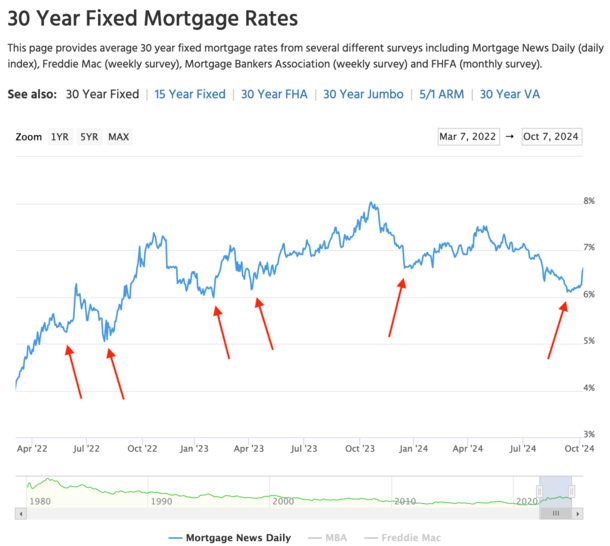Ever since the Fed announced their 50-basis point cut, mortgage rates have been climbing higher.
In fact, they’re basically 50 bps higher since the Fed cut their own federal funds rate (FFR) 50 bps lower.
While we know the Fed doesn’t control mortgage rates, it does seem unusual to see such a disconnect.
But the first important thing to remember here is the Fed’s rate is a short-term one, and mortgage rate are long-term rates, aka the 30-year fixed.
So it’s not really about the Fed. However, this is a good reminder that mortgage rate trends never move in a straight line.
Mortgage Rates Seesawed on the Way Up

If you recall mortgage rates’ ascent from sub-3% to 8% (yes, 8%!), it wasn’t just a straight line up.
Just take a look at my annotated chart from Mortgage News Daily for evidence of this, where I highlighted all the pullbacks.
There were days, weeks, and even months when mortgage rates went down. For example, the 30-year fixed climbed from around 3% in January 2022 to roughly 6.25% that June.
Then mortgage rates “rallied” a bit and fell to around 5% (quotes in the high-4% range) by that August.
Did that mean the worst was behind us? Nope. It sure didn’t. Instead, mortgage rates resurged and climbed to a new cycle high above 7% by that October.
Things were looking pretty bleak until another relief rally took place, sending the 30-year fixed back down to 5.99% by February 2023.
At that point, things were beginning to look better. Maybe that was the worst of it. Wrong again!
Mortgage rates did an about-face in March and made the spring home buying season a lot less pleasant for home buyers.
Then rates got even worse, rising north of 8% by mid-October and making folks question whether double-digit rates were the next stop.
It turned out that was the worst of it, despite all the head fakes and twists and turns along the way.
But it took time to realize that it was finally behind us. And it took false peaks and short-lived valleys for us to get there.
Mortgage Rates Are Falling Now and the Same Thing Is Happening
Now that mortgage rates appeared to have peaked this cycle (I say appear because there’s never ever any guarantee), we’ve been in a downtrend for about a year.
Rates hit their cycle highs last October at around 8% before rallying lower as inflation concerns subsided and unemployment began to worsen.
In short, the overheating economy seemed to run out of steam, and interest rates took solace from that.
It took just two short months for the 30-year fixed to fall from that 8% peak to around 6.5% last December.
And it appeared that the 2024 spring home buying season was going to be a pretty good one, at least with regard to rates.
But guess what happened. Yes, you’re catching on now. Mortgage rates went up. Again! What gives?
Well, similar to the way up, there was economic data released each month that led to bond selloffs, which increased their accompanying yields.
The 10-year bond yield, which tracks mortgage rates really well, had fallen to around 3.75% in December, only to rise about one full percentage point by April.
That pushed mortgage rates back up to around 7.50%, enough to ruin yet another peak home buying season.
Then as if almost on cue, mortgage rates trickled down post-spring to just above 6% in September.
At that time, you could actually get a rate that started with a “4” in certain situations. And rates in the low-to-mid 5s were also quite common.
Good Economic News Ruined the Mortgage Rate Party
In early September, it seemed like the worst truly was over, and just then an optimistic Fed chairman Powell and a jobs report beat surfaced.
The 50-basis point Fed rate cut didn’t really have much of an impact, given it was baked in and telegraphed.
But Powell made comments the same day, essentially proclaiming that the 50-bps cut was bullish because the economy was so in such good shape it could handle a larger cut without reigniting inflation.
Then came the jobs report just over a week later, which was a big beat and enough to propel rates above 6.50%.
If it feels like déjà vu, you’re not wrong, nor are you alone. However, you might take comfort in knowing this same exact thing happened on the way up.
Mortgage rates did not move in a straight line up, and will not move in a straight line down. There will be bad days, weeks, and even months along the way.
Despite this, the trend still feels decidedly lower over time. You just have to be patient and focus less on the day-to-day.
Easier said than done if you’re a loan officer or mortgage broker, or a borrower who needs to lock or float your rate, I know.
If you do have time to wait before buying a home (or refinancing), it might pay to sit back and wait for this trend to continue developing.
After all, the fed funds rate is still expected to fall another 150 bps within a year. And chances are they wouldn’t keep cutting that much if the economy was still running hot.
In summary, trends, whether it’s rising rates or falling rates, take time to develop. Zoom out. Before long, the chart might resemble a “head and shoulders” pattern that slopes down on the right-hand side.

